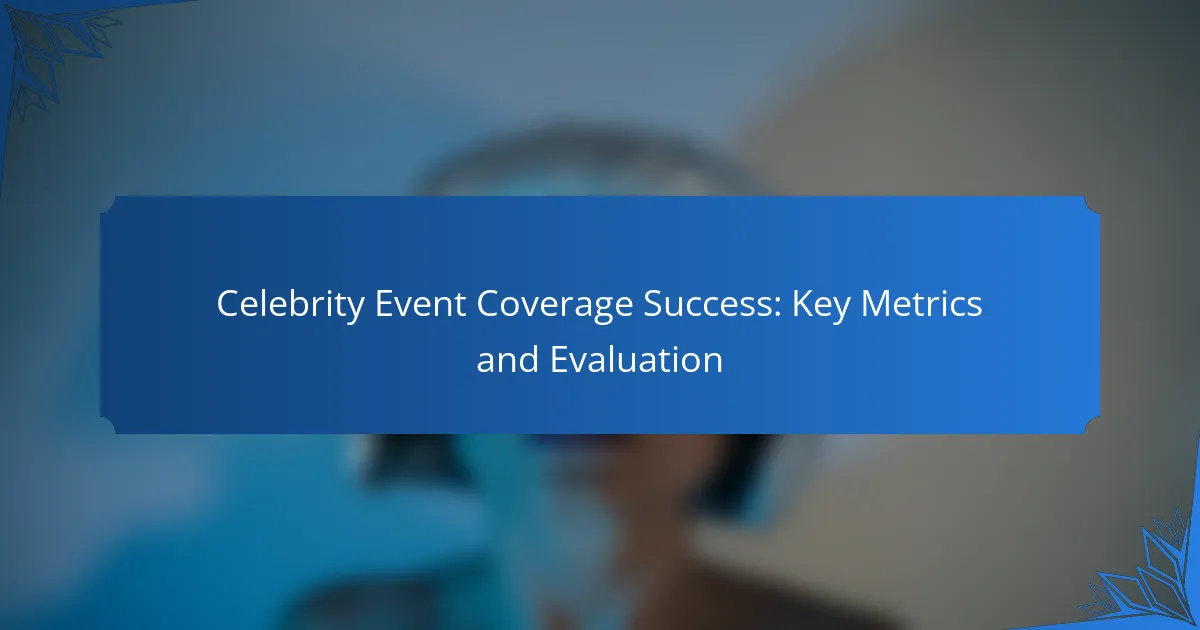Success in celebrity event coverage is determined by analyzing key metrics that reflect audience engagement and overall impact. By focusing on indicators such as media exposure, social media interactions, and audience demographics, organizers can effectively evaluate the event’s success and refine future strategies for maximum reach and engagement.
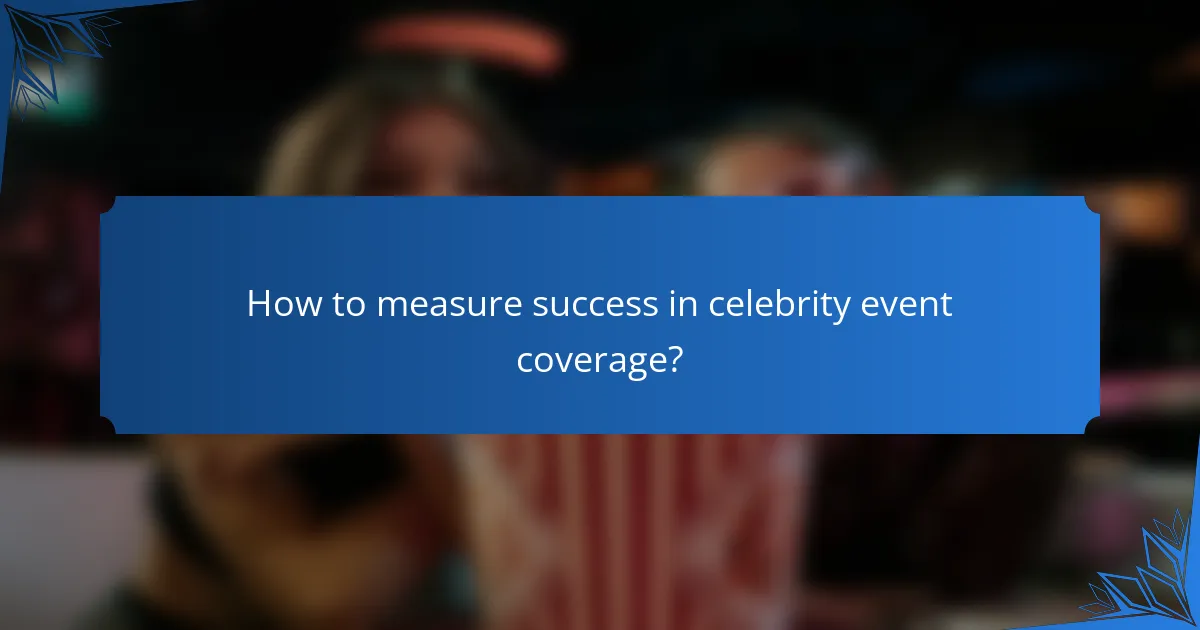
How to measure success in celebrity event coverage?
Measuring success in celebrity event coverage involves analyzing various metrics that reflect audience engagement, reach, and overall impact. Key indicators include engagement metrics, reach and impressions, conversion rates, audience demographics, and social media interactions.
Engagement metrics
Engagement metrics are critical for understanding how audiences interact with celebrity event content. Key measures include likes, shares, comments, and time spent on content. High engagement rates often indicate that the content resonates well with the audience.
To effectively track engagement, use analytics tools that provide insights into user behavior. Aim for engagement rates that exceed industry averages, which typically range from 1% to 5% for social media platforms.
Reach and impressions
Reach refers to the total number of unique users who see your content, while impressions indicate how many times the content is displayed, regardless of clicks. Both metrics are essential for gauging the visibility of celebrity event coverage.
To maximize reach, consider leveraging multiple platforms and promotional strategies, such as influencer partnerships or targeted ads. Aiming for a reach that is at least three times your follower count can be a good benchmark.
Conversion rates
Conversion rates measure the percentage of users who take a desired action after engaging with your content, such as signing up for a newsletter or purchasing tickets. This metric is vital for assessing the effectiveness of your coverage in driving tangible outcomes.
To improve conversion rates, ensure that calls-to-action are clear and compelling. A typical conversion rate for online campaigns can range from 2% to 5%, but this can vary based on the industry and audience targeting.
Audience demographics
Understanding audience demographics helps tailor content to specific groups, enhancing relevance and engagement. Key demographic factors include age, gender, location, and interests, which can influence how celebrity events are perceived.
Utilize analytics tools to gather demographic data and adjust your coverage strategy accordingly. For instance, if a significant portion of your audience is under 30, consider focusing on platforms like TikTok or Instagram for promotion.
Social media interactions
Social media interactions encompass all forms of engagement on platforms like Twitter, Instagram, and Facebook. These interactions provide real-time feedback on audience sentiment and content effectiveness.
To boost social media interactions, create shareable content that encourages audience participation, such as polls or contests. Monitoring interactions can help identify trends and inform future coverage strategies, aiming for consistent growth in engagement over time.

What are the key performance indicators for celebrity events?
Key performance indicators (KPIs) for celebrity events include metrics that assess media exposure, audience engagement, and overall brand impact. These indicators help organizers evaluate the success of the event and inform future strategies.
Media mentions
Media mentions track how often an event is referenced across various platforms, including news articles, blogs, and social media. A high volume of mentions typically indicates strong public interest and visibility.
To measure media mentions effectively, utilize tools like Google Alerts or social listening platforms. Aim for a diverse range of mentions across both traditional and digital media to capture a comprehensive view of the event’s reach.
Brand sentiment analysis
Brand sentiment analysis evaluates the public’s emotional response to an event, determining whether the sentiment is positive, negative, or neutral. This analysis can be conducted through social media monitoring and surveys.
Consider using sentiment analysis tools that provide insights into audience reactions. A favorable sentiment score can enhance brand reputation, while negative feedback may highlight areas for improvement.
Traffic sources
Traffic sources refer to the channels through which attendees and online audiences engage with event content, such as social media, email campaigns, or direct visits to the event website. Understanding these sources helps in optimizing marketing efforts.
Use analytics tools like Google Analytics to track where your traffic originates. Focus on channels that yield the highest engagement rates, and consider adjusting your promotional strategies based on this data.
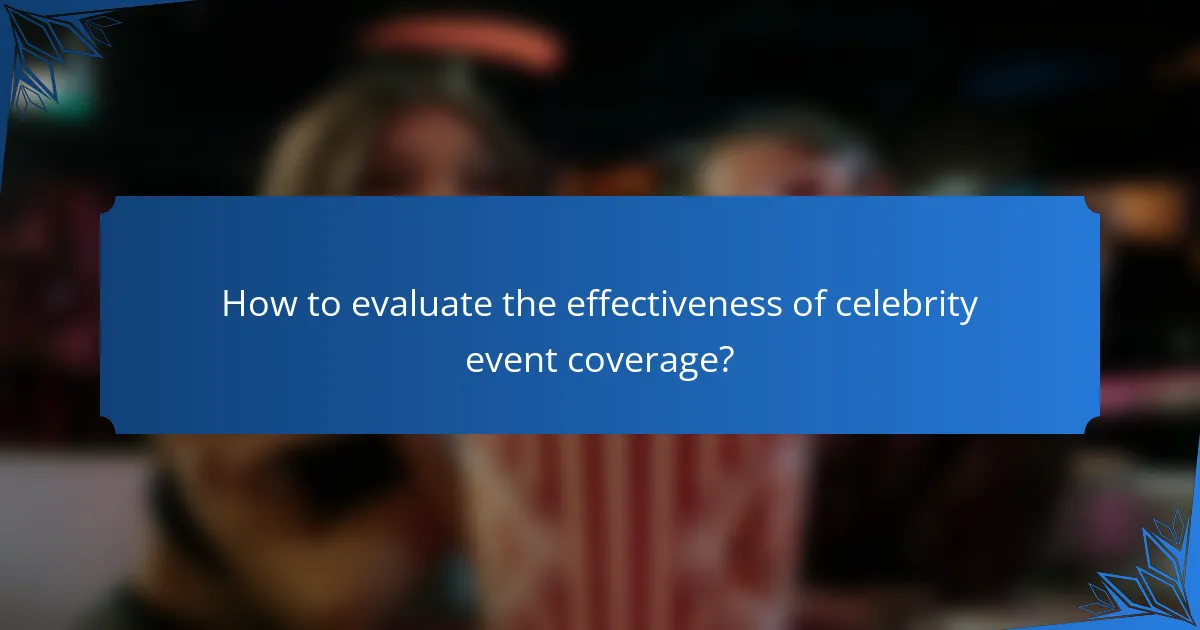
How to evaluate the effectiveness of celebrity event coverage?
Evaluating the effectiveness of celebrity event coverage involves assessing audience engagement, media reach, and overall impact on brand perception. Key metrics include social media interactions, press mentions, and audience feedback to gauge success.
Post-event surveys
Post-event surveys are a direct way to gather feedback from attendees and viewers about their experience. These surveys can include questions about satisfaction levels, perceived value, and overall impressions of the event. Aim for a response rate of at least 20-30% to ensure representative feedback.
Consider using a mix of quantitative and qualitative questions to capture both measurable data and personal insights. For example, ask participants to rate their experience on a scale of 1 to 10, followed by an open-ended question about what they enjoyed most.
ROI analysis
ROI analysis helps determine the financial effectiveness of the event coverage by comparing the costs incurred to the benefits gained. Calculate the total expenses, including marketing, production, and talent fees, against the revenue generated through ticket sales, sponsorships, and merchandise. A positive ROI indicates a successful event.
When conducting ROI analysis, consider both direct and indirect benefits. For instance, increased brand awareness and social media growth can be harder to quantify but are crucial for long-term success. A good rule of thumb is to aim for an ROI of at least 3:1, meaning for every dollar spent, three dollars should be returned in value.

What tools can enhance celebrity event coverage metrics?
Several tools can significantly improve the metrics associated with celebrity event coverage, allowing for better analysis and evaluation of audience engagement. Utilizing these tools can help identify trends, measure reach, and optimize future coverage strategies.
Google Analytics
Google Analytics is a powerful tool for tracking website traffic and user behavior during celebrity events. By setting up specific goals and events, you can monitor how visitors interact with your event-related content, such as articles, videos, or live streams.
To maximize its effectiveness, ensure that you implement tracking codes on all relevant pages and set up custom dashboards to focus on metrics like page views, average session duration, and bounce rates. Regularly review these metrics to adjust your content strategy based on audience preferences.
Social media analytics platforms
Social media analytics platforms, such as Hootsuite, Sprout Social, or Buffer, provide insights into audience engagement across various social networks. These tools can help you track metrics like likes, shares, comments, and overall reach during celebrity events.
Consider using these platforms to analyze sentiment and engagement trends in real-time. This data can inform your coverage strategy, allowing you to highlight popular moments or adjust your messaging to better resonate with your audience.
Media monitoring services
Media monitoring services, such as Meltwater or Cision, help track mentions of celebrities and events across news outlets, blogs, and social media. These services provide comprehensive reports on how events are being covered and perceived in the media landscape.
Utilizing these services can help you gauge public interest and sentiment, as well as identify key influencers discussing the event. Regularly review media coverage to understand trends and adjust your outreach efforts accordingly, ensuring your coverage remains relevant and impactful.
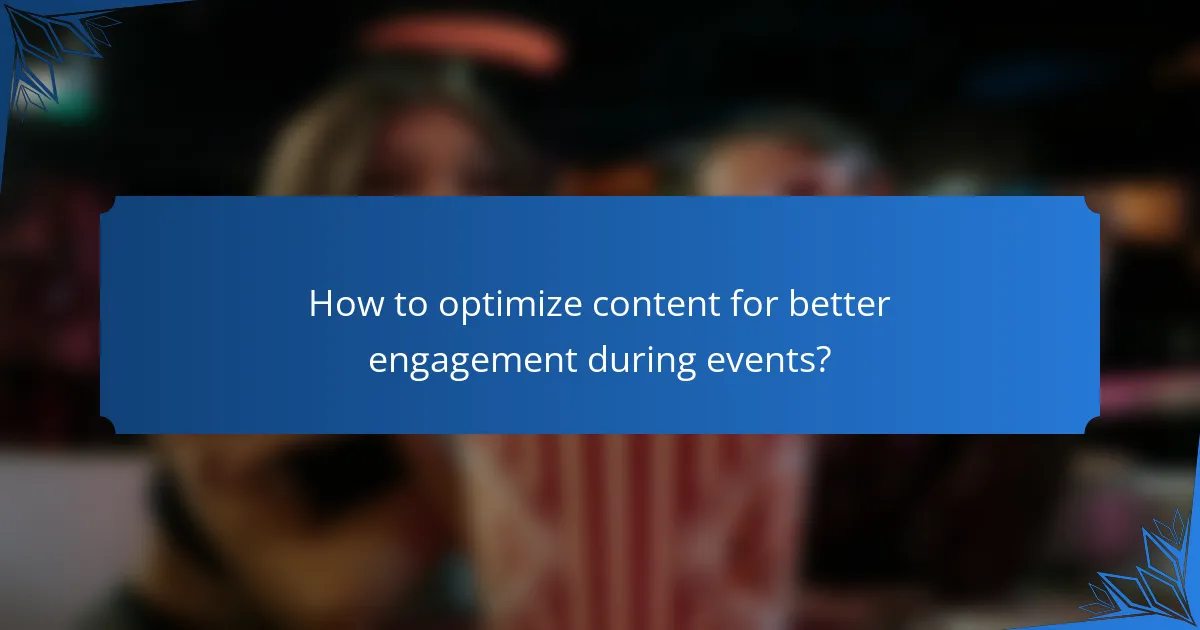
How to optimize content for better engagement during events?
To optimize content for better engagement during events, focus on delivering timely and relevant information that resonates with your audience. Utilize various formats and interactive elements to keep viewers interested and encourage participation.
Real-time updates
Real-time updates are crucial for maintaining audience engagement during events. Providing live coverage through social media, blogs, or dedicated event pages allows followers to stay informed and feel connected. Aim for updates every few minutes to keep the content fresh and engaging.
Consider using a mix of text, images, and short video clips to enhance the updates. For instance, sharing quick highlights or behind-the-scenes moments can create a more immersive experience. Ensure that updates are concise and focused on key developments to avoid overwhelming your audience.
Interactive content
Interactive content significantly boosts engagement by inviting audience participation. Polls, quizzes, and live Q&A sessions can encourage viewers to interact with the event in real-time. This not only increases engagement but also provides valuable insights into audience preferences and opinions.
Incorporate tools like live chat features or social media hashtags to facilitate discussions among attendees. For example, using a dedicated hashtag can help aggregate audience reactions and create a sense of community. Always monitor interactions to respond promptly and keep the conversation flowing.
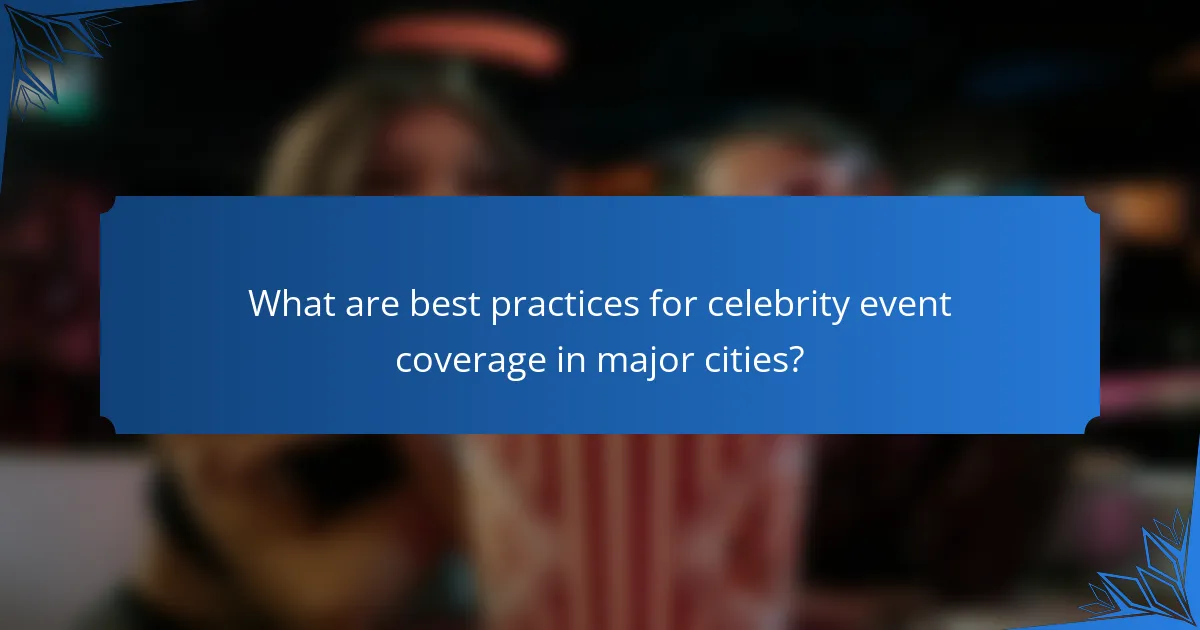
What are best practices for celebrity event coverage in major cities?
Best practices for celebrity event coverage in major cities include thorough planning, real-time engagement, and leveraging social media. Successful coverage requires understanding the event’s dynamics, audience expectations, and utilizing various platforms to maximize reach and impact.
Planning and Preparation
Effective planning is crucial for successful coverage of celebrity events. This involves researching the event, identifying key personalities, and understanding the venue layout. Create a timeline that outlines critical moments, such as red carpet arrivals or performances, to ensure comprehensive coverage.
Consider logistics like transportation, equipment needs, and potential obstacles. For instance, if covering an event in Los Angeles, be aware of traffic patterns and parking regulations that may affect your schedule.
Real-Time Engagement
Real-time engagement is essential for capturing the excitement of celebrity events. Utilize live streaming and social media updates to keep your audience informed and engaged. Platforms like Instagram and Twitter are particularly effective for sharing instant highlights and behind-the-scenes content.
Encourage audience interaction by asking questions or hosting polls during the event. This not only boosts engagement but also provides valuable insights into audience preferences and reactions.
Utilizing Social Media
Social media is a powerful tool for amplifying event coverage. Tailor your content for different platforms to maximize reach; for example, use Instagram for visual storytelling and Twitter for quick updates. Hashtags specific to the event can help increase visibility and connect with broader conversations.
Monitor social media trends related to the event to stay relevant. Engaging with fans and responding to comments can enhance your coverage and build a loyal following.
